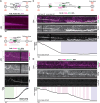This is a preprint.
A non-catalytic role for RFC in PCNA-mediated processive DNA synthesis
- PMID: 40832337
- PMCID: PMC12363810
- DOI: 10.1101/2025.08.08.669392
A non-catalytic role for RFC in PCNA-mediated processive DNA synthesis
Abstract
The ring-shaped sliding clamp PCNA enables DNA polymerases to perform processive DNA synthesis during replication and repair. The loading of PCNA onto DNA is catalyzed by the ATPase clamp loader RFC. Using a single-molecule platform to visualize the dynamic interplay between PCNA and RFC on DNA, we unexpectedly discovered that RFC continues to associate with PCNA after loading, contrary to the conventional view. Functionally, this clamp-loader/clamp complex is required for processive DNA synthesis by polymerase δ (Polδ), as the PCNA-Polδ assembly is inherently unstable. This architectural role of RFC is dependent on the BRCT domain of Rfc1, and mutation of its DNA-binding residues causes sensitivity to DNA damage in vivo. We further showed the FEN1 flap endonuclease can also stabilize the PCNA-Polδ interaction and mediate robust synthesis. Overall, our work revealed that, beyond their canonical enzymatic functions, PCNA-binding proteins harbor non-catalytic functions essential for DNA replication and genome maintenance.
Conflict of interest statement
DECLARATION OF INTERESTS
The authors declare no competing interests.
Figures







Similar articles
-
Structure of the human CTF18-RFC clamp loader bound to PCNA.bioRxiv [Preprint]. 2025 Jul 24:2024.05.08.593111. doi: 10.1101/2024.05.08.593111. bioRxiv. 2025. PMID: 40777363 Free PMC article. Preprint.
-
PCNA is a Nucleotide Exchange Factor for the Clamp Loader ATPase Complex.bioRxiv [Preprint]. 2025 Jul 3:2025.07.02.662830. doi: 10.1101/2025.07.02.662830. bioRxiv. 2025. PMID: 40631102 Free PMC article. Preprint.
-
Direct, ensemble FRET approaches to monitor transient state kinetics of human DNA polymerase δ holoenzyme assembly and initiation of DNA synthesis.Methods Enzymol. 2024;705:271-309. doi: 10.1016/bs.mie.2024.08.002. Epub 2024 Aug 28. Methods Enzymol. 2024. PMID: 39389667 Free PMC article.
-
How lived experiences of illness trajectories, burdens of treatment, and social inequalities shape service user and caregiver participation in health and social care: a theory-informed qualitative evidence synthesis.Health Soc Care Deliv Res. 2025 Jun;13(24):1-120. doi: 10.3310/HGTQ8159. Health Soc Care Deliv Res. 2025. PMID: 40548558
-
Functions of Multiple Clamp and Clamp-Loader Complexes in Eukaryotic DNA Replication.Adv Exp Med Biol. 2017;1042:135-162. doi: 10.1007/978-981-10-6955-0_7. Adv Exp Med Biol. 2017. PMID: 29357057 Review.
References
-
- Stillman B., Smart machines at the DNA replication fork. Cell, 1994. 78(5): p. 725–728. - PubMed
-
- Benkovic S.J., Valentine A.M., and Salinas F., Replisome-Mediated DNA Replication. Annual Review of Biochemistry, 2001. 70(Volume 70, 2001): p. 181–208. - PubMed
-
- Johnson A. and O’Donnell M., Cellular DNA replicases: components and dynamics at the replication fork. Annu Rev Biochem, 2005. 74: p. 283–315. - PubMed
-
- Krishna T.S.R., et al. , Crystal structure of the eukaryotic DNA polymerase processivity factor PCNA. Cell, 1994. 79(7): p. 1233–1243. - PubMed
-
- Gulbis J.M., et al. , Structure of the C-terminal region of p21(WAF1/CIP1) complexed with human PCNA. Cell, 1996. 87(2): p. 297–306. - PubMed
Publication types
LinkOut - more resources
Full Text Sources
Miscellaneous
